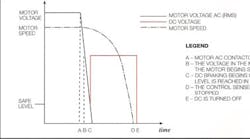To stop, you don’t always need friction; sometimes you might want to try a circuit board and motor instead.
There are numerous ways of making a motor do the braking. Some methods convert mechanical energy back to electrical, essentially turning the motor into a generator. Generated energy then dissipates as heat in a resistor or is returned to the electric lines. This regenerative braking will slow the load, but will not hold it stopped. Furthermore, as the machine winds down and is near to stopping, very little energy is left to excite the motor-turned-generator; therefore the machinery will essentially coast to rest unless additional braking measures are applied.
Another approach involves the injection of dc current into an ac motor. The exact setup and application varies, as do ac motor designs. But in general, after the ac motor’s rotating magnetic field is turned off, dc current is injected into the stator. Not into all the windings – it may be, say, only one out of a total of three. This sets up a stationary (non-rotating) magnetic field that grabs at the rotor from two points on opposite sides of the stator. The spinning rotor tries to align itself with this field and, along with the load, is stopped in short order.
Dc-injection braking, while often used alone, may also be applied at the end of a regenerative braking cycle to decisively stop and hold the load. This twofold scheme is “true” electronic braking. Energized dc brakes will hold a load stationary, but they are reliant on supply power and motor integrity and are not meant to be failsafe or holding brakes.
Questions & Answers
Q: Should I size the motor differently when it doubles as a brake?
A: Every occurrence of dc-injection braking should be weighed the same as a motor startup; include both starts and stops when calculating duty cycle. To size the brake (the “dc injector”) refer to the motor’s full-load current and operating voltage.
Q: How fast can it stop?
A: Dc brakes are generally able to stop a load more quickly than the motor can accelerate it to speed. This could, however, be damaging to the motor (and the rest of the drive), so it’s generally advisable to let the motor stop no faster than it starts.
Q: What about heat and electrical damage?
A: Overheating problems can occur in the motor if braking current is applied for too long. To prevent this, zero-speed sensors are used to cut dc current immediately after stopping. Surge currents, another potential hazard, can damage fuses and contacts. This is particularly likely if dc is applied before the operating voltage has had a chance to sufficiently subside after ac is cut. A common way to help avoid oversurge is to use a fixed time delay. Another method is to monitor the voltage and trigger the dc contact accordingly. The control might also be built to block out simultaneous ac and dc contact closure. The brake can be connected to a motor overload device as well
